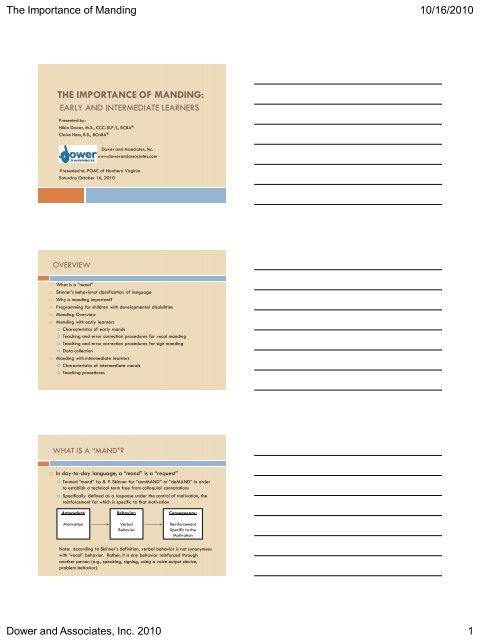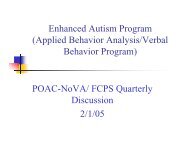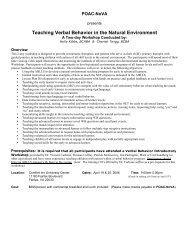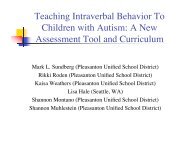the importance of manding - Parents Of Autistic Children of Northern ...
the importance of manding - Parents Of Autistic Children of Northern ...
the importance of manding - Parents Of Autistic Children of Northern ...
You also want an ePaper? Increase the reach of your titles
YUMPU automatically turns print PDFs into web optimized ePapers that Google loves.
The Importance <strong>of</strong> Manding 10/16/2010<br />
THE IMPORTANCE OF MANDING:<br />
EARLY AND INTERMEDIATE LEARNERS<br />
Presented by:<br />
Nikia Dower, M.S., CCC-SLP/L, BCBA ®<br />
Claire Hess, B.S., BCaBA ®<br />
Dower and Associates, Inc.<br />
www.dowerandassociates.com<br />
•Presented to: POAC <strong>of</strong> Nor<strong>the</strong>rn Virginia<br />
Saturday October 16, 2010<br />
OVERVIEW<br />
� What is a “mand”<br />
� Skinner’s behavioral classification <strong>of</strong> language<br />
� Why is <strong>manding</strong> important?<br />
� Programming for children with developmental disabilities<br />
� Manding Overview<br />
� Manding with early learners<br />
� Characteristics <strong>of</strong> early mands<br />
� Teaching and error correction procedures for vocal <strong>manding</strong><br />
� Teaching and error correction procedures for sign <strong>manding</strong><br />
� Data collection<br />
� Manding with intermediate learners<br />
� Characteristics <strong>of</strong> intermediate mands<br />
� Teaching procedures<br />
WHAT IS A “MAND”?<br />
� In day-to-day language, a “mand” is a “request”<br />
� Termed “mand” by B. F. Skinner for “comMAND” or “deMAND” in order<br />
to establish a technical term free from colloquial connotations<br />
� Specifically defined as a response under <strong>the</strong> control <strong>of</strong> motivation, <strong>the</strong><br />
reinforcement for which is specific to that motivation<br />
Antecedent:<br />
Motivation<br />
Behavior:<br />
Verbal<br />
Behavior<br />
Consequence:<br />
Reinforcement<br />
Specific to <strong>the</strong><br />
Motivation<br />
Note: According to Skinner’s definition, verbal behavior is not synonymous<br />
with “vocal” behavior. Ra<strong>the</strong>r, it is any behavior reinforced through<br />
ano<strong>the</strong>r person (e.g., speaking, signing, using a voice output device,<br />
problem behavior).<br />
Dower and Associates, Inc. 2010 1
The Importance <strong>of</strong> Manding 10/16/2010<br />
SKINNER’S BEHAVIORAL CLASSIFICATION OF<br />
LANGUAGE<br />
Intraverbal<br />
VERBAL OPERANTS<br />
Tact<br />
LRFFC<br />
• Mand (comMAND, deMAND)/Request: asking<br />
for something when <strong>the</strong>re is motivation for it<br />
• Tact (conTACT)/Label: labeling something in<br />
<strong>the</strong> environment when it is contacted by any<br />
sensory modality<br />
• Echoic/Mimetic: saying or signing <strong>the</strong> same<br />
thing immediately after someone else says or<br />
signs it<br />
• Intraverbal: communicating about something<br />
not present in <strong>the</strong> environment in response to<br />
someone else’s verbal behavior<br />
COOKIE<br />
Mand<br />
Receptive<br />
WHY IS MANDING IMPORTANT?<br />
Echoic/Mimetic<br />
NONVERBAL BEHAVIOR<br />
• LRFFC: finding something when told its<br />
feature, function, or class<br />
• Receptive: responding physically to someone<br />
else’s verbal behavior (i.e., reinforcing<br />
someone else’s mand)<br />
� First repertoire learned by typically-developing children<br />
� Addresses <strong>the</strong> primary deficits <strong>of</strong> children with developmental<br />
disabilities: functional communication, social, maladaptive<br />
behaviors including self-stimulatory and problem behaviors)<br />
� Only form <strong>of</strong> verbal behavior that produces immediate benefit<br />
for <strong>the</strong> speaker<br />
� Development <strong>of</strong> spontaneous language<br />
� Development <strong>of</strong> <strong>the</strong> mand repertoire may facilitate<br />
development <strong>of</strong> o<strong>the</strong>r language repertoires<br />
� May produce positive by products (e.g., eye contact)<br />
PROGRAMMING FOR CHILDREN WITH<br />
DEVELOPMENTAL DISABILITIES<br />
� <strong>Of</strong>ten depending on <strong>the</strong> extent to which applied behavior analytic<br />
programming incorporates Skinner’s behavioral analysis <strong>of</strong> language<br />
and verbal behavior, <strong>the</strong>re are varying degrees <strong>of</strong> similarity and<br />
dissimilarity in programming; some fundamental similarities are<br />
maintained along with some fundamental differences in analysis and<br />
focus<br />
� Similarities:<br />
� Same reliance on basic behavioral principles that account for<br />
learning<br />
� Precise organization <strong>of</strong> learning environments<br />
� Emphasis on early intervention<br />
� Teaching <strong>of</strong> speaker and listener behavior<br />
� Reliance on behavior analytic literature to support and guide<br />
effective intervention<br />
Dower and Associates, Inc. 2010 2
The Importance <strong>of</strong> Manding 10/16/2010<br />
� Differences:<br />
“Traditional” behavior-analytic<br />
programming<br />
� Early focus on vocal imitation,<br />
labeling, attending, imitation,<br />
receptive, and table teaching<br />
skills<br />
MANDING OVERVIEW<br />
� Pairing<br />
Programming that emphasizes<br />
Skinner’s analysis <strong>of</strong> verbal<br />
behavior<br />
� Associate yourself with improving conditions<br />
� Early focus on teaching in <strong>the</strong><br />
context <strong>of</strong> motivation and on<br />
developing <strong>the</strong> <strong>manding</strong><br />
repertoire<br />
� The use <strong>of</strong> assessments (e.g.,<br />
Assessment <strong>of</strong> Basic Language<br />
and Learning Skills (ABLLS or<br />
ABLLS- R) and <strong>the</strong> Verbal<br />
Behavior – Milestones<br />
Assessment and Placement<br />
Program (VB-MAPP)) based<br />
upon Skinner’s analysis <strong>of</strong><br />
verbal behavior to facilitate<br />
intervention<br />
� Make yourself “number two”… become <strong>the</strong> M & M<br />
� Surround yourself with reinforcers and deliver reinforcers<br />
non-contingently (requiring no effort)<br />
� Be a giver and not a taker<br />
� Be a “conveyer belt <strong>of</strong> fun”<br />
� Think <strong>of</strong> pairing as making “deposits in a bank”<br />
� Pairing is a process that looks different and takes varying<br />
amounts <strong>of</strong> time depending on <strong>the</strong> learner<br />
VIDEO<br />
MANDING OVERVIEW (continued)<br />
� Manding<br />
� Manding as <strong>the</strong> first response required<br />
� Capture and contrive motivation across reinforcers, types <strong>of</strong> motivation,<br />
settings, and people<br />
� Take advantage <strong>of</strong> existing motivation and contrive new motivation<br />
� Teach strongest motivators first (not most socially appropriate or<br />
generalized)<br />
� NOT “please,” “thank you,” “more,” “help,” “yes,” “no”<br />
� Teach mands that are very topographically distinct initially<br />
� Incorporate hundreds <strong>of</strong> trials throughout each day<br />
� Practice reading “declarations <strong>of</strong> motivation”<br />
� Make talking easy, especially at first<br />
� Fade prompts as quickly as possible, without allowing errors that make<br />
communicating effortful or frustrating<br />
Dower and Associates, Inc. 2010 3
The Importance <strong>of</strong> Manding 10/16/2010<br />
MANDING WITH EARLY LEARNERS<br />
CHARACTERISTICS OF EARLY MANDS<br />
� Prompted mands <strong>of</strong> any form (vocal, sign, PECS, picture<br />
exchange, voice output device)<br />
� Manding under <strong>the</strong> control <strong>of</strong> item presence<br />
� Developing a few spontaneous (i.e., under motivational control<br />
without <strong>the</strong> item present) mands<br />
� Generalizing a few mands across settings, people, and<br />
reinforcer exemplars (i.e., different examples <strong>of</strong> <strong>the</strong> same<br />
item)<br />
TEACHING PROCEDURE: VOCAL MANDING<br />
� Vocal <strong>manding</strong> prompt hierarchy<br />
1. Vocal (echoic) prompt: reinforcer name<br />
2. Item present<br />
3. Motivation is strong<br />
Dower and Associates, Inc. 2010 4
The Importance <strong>of</strong> Manding 10/16/2010<br />
TEACHING PROCEDURE: VOCAL MANDING<br />
1. When a learner declares motivation for a reinforcer and does not<br />
say <strong>the</strong> item name:<br />
� Vocally prompt and wait up to 3 seconds for <strong>the</strong> learner to echo<br />
� If <strong>the</strong> learner echoes your vocal prompt, immediately deliver<br />
<strong>the</strong> reinforcer<br />
� If <strong>the</strong> learner does not immediately echo your vocal prompt,<br />
model up to three times<br />
� If, at any point during <strong>the</strong> three echoic trials, <strong>the</strong> learner<br />
echoes, deliver <strong>the</strong> reinforcer<br />
� If <strong>the</strong> learner has not echoed your vocal prompt by <strong>the</strong><br />
third echoic trial, deliver a small amount <strong>of</strong> <strong>the</strong> reinforcer<br />
VIDEO<br />
TEACHING PROCEDURE: VOCAL MANDING<br />
2. Once a learner is consistently echoing <strong>the</strong> vocal prompt on <strong>the</strong> first<br />
trial, begin to transfer control from <strong>the</strong> vocal prompt to <strong>the</strong> item<br />
presence:<br />
� Vocally prompt and wait up to 3 seconds for <strong>the</strong> learner to echo<br />
� If <strong>the</strong> learner echoes your vocal prompt, DO NOT immediately<br />
deliver <strong>the</strong> reinforcer; ra<strong>the</strong>r, wait up to 3 seconds for <strong>the</strong><br />
learner to mand again independently<br />
� If <strong>the</strong> learner mands independently within <strong>the</strong> 3 seconds,<br />
immediately deliver <strong>the</strong> reinforcer<br />
� If <strong>the</strong> learner has not manded by <strong>the</strong> end <strong>of</strong> <strong>the</strong> 3 seconds,<br />
vocally prompt <strong>the</strong> mand and, after <strong>the</strong> learner echoes,<br />
deliver a small amount <strong>of</strong> <strong>the</strong> reinforcer<br />
VIDEO-1<br />
VIDEO-2<br />
TEACHING PROCEDURE: VOCAL MANDING<br />
3. Once a learner is consistently <strong>manding</strong> under <strong>the</strong> control <strong>of</strong> <strong>the</strong> item,<br />
begin to transfer control from <strong>the</strong> item presence to motivational<br />
control:<br />
� After <strong>the</strong> learner has declared motivation, wait up to 3 seconds for<br />
<strong>the</strong> mand under <strong>the</strong> control <strong>of</strong> <strong>the</strong> item presence<br />
� If <strong>the</strong> learner mands under <strong>the</strong> control <strong>of</strong> <strong>the</strong> item, DO NOT<br />
immediately deliver <strong>the</strong> reinforcer; ra<strong>the</strong>r, remove <strong>the</strong> item from<br />
sight and wait up to 3 seconds for <strong>the</strong> learner to mand under<br />
motivational control<br />
� If <strong>the</strong> learner mands in <strong>the</strong> absence <strong>of</strong> <strong>the</strong> item within <strong>the</strong> 3<br />
seconds, immediately deliver <strong>the</strong> reinforcer<br />
� If <strong>the</strong> learner has not manded by <strong>the</strong> end <strong>of</strong> <strong>the</strong> 3 seconds,<br />
return <strong>the</strong> item to sight, wait up to 3 seconds for <strong>the</strong> learner to<br />
mand, and <strong>the</strong>n deliver a small amount <strong>of</strong> <strong>the</strong> reinforcer<br />
Dower and Associates, Inc. 2010 5
The Importance <strong>of</strong> Manding 10/16/2010<br />
ERROR CORRECTION PROCEDURE:<br />
VOCAL MANDING<br />
� Types <strong>of</strong> <strong>manding</strong> errors:<br />
� “Scrolling”<br />
� A learner declares motivation for a reinforcer and emits a mand<br />
that corresponds with a different reinforcer<br />
� A learner chains toge<strong>the</strong>r two or more mands<br />
� A learner “self-corrects”<br />
� Repetitive <strong>manding</strong><br />
� A learner repeats <strong>the</strong> mand that corresponds with <strong>the</strong> declared<br />
motivation<br />
� Error correction procedure:<br />
� Wait for a 3- to 5-second break in <strong>manding</strong><br />
� Vocally prompt <strong>the</strong> appropriate mand<br />
� Immediately after <strong>the</strong> learner emits <strong>the</strong> appropriate mand, deliver <strong>the</strong><br />
reinforcer<br />
VIDEO<br />
DATA COLLECTION: VOCAL MANDING<br />
DATA COLLECTION SAMPLE: VOCAL MANDING<br />
Dower and Associates, Inc. 2010 6
The Importance <strong>of</strong> Manding 10/16/2010<br />
IF THE VOCAL AND ECHOIC REPERTOIRES ARE<br />
NOT YET DEVELOPING…<br />
� When a learner is not yet emitting vocal behavior and is not yet<br />
developing an echoic repertoire, it is important to consider a form<br />
<strong>of</strong> alternative and augmentative communication (AAC)<br />
� The focus <strong>of</strong> our current discussion is not <strong>the</strong> assessment <strong>of</strong> various<br />
forms <strong>of</strong> AAC; we will be discussing <strong>the</strong> instruction <strong>of</strong> sign language<br />
as a form <strong>of</strong> AAC for learners who have not yet developed vocal<br />
and echoic repertoires<br />
� Some benefits to sign language as a form <strong>of</strong> AAC include:<br />
� Constant availability <strong>of</strong> <strong>the</strong> hands<br />
� Development <strong>of</strong> a full verbal behavior repertoire<br />
� <strong>Of</strong>ten, quicker acquisition<br />
� Frequently, greater reductions in problem behavior functioning as<br />
a mand<br />
� Facilitation <strong>of</strong> vocal productions<br />
TEACHING PROCEDURE: SIGN MANDING<br />
� Sign <strong>manding</strong> prompt hierarchy<br />
1. Physical prompt<br />
2. Model/Gestural prompt<br />
3. Item present<br />
4. Motivation is strong<br />
TEACHING PROCEDURE: SIGN MANDING<br />
1. When a learner declares motivation for a reinforcer and<br />
does not emit a sign:<br />
� Quickly model <strong>the</strong> sign and provide a most-effective, leastintrusive<br />
physical prompt (i.e., full physical or partial<br />
physical) to help <strong>the</strong> learner sign<br />
� After <strong>the</strong> learner’s hand(s) are forming <strong>the</strong> appropriate<br />
sign, immediately deliver <strong>the</strong> reinforcer<br />
Note: <strong>the</strong> item name should be said repeatedly throughout<br />
this procedure<br />
VIDEO<br />
Dower and Associates, Inc. 2010 7
The Importance <strong>of</strong> Manding 10/16/2010<br />
TEACHING PROCEDURE: SIGN MANDING<br />
2. Once a learner is consistently <strong>manding</strong> with almost no physical prompting,<br />
begin to transfer control from <strong>the</strong> physical prompt to <strong>the</strong> model/gestural<br />
prompt:<br />
� Model <strong>the</strong> sign and wait up to 3 seconds for <strong>the</strong> learner to imitate<br />
� If <strong>the</strong> learner imitates your model prompt, immediately deliver <strong>the</strong><br />
reinforcer<br />
� If <strong>the</strong> learner does not imitate your model within <strong>the</strong> 3 seconds,<br />
provide a most-effective, least-intrusive physical prompt and<br />
immediately deliver a small amount <strong>of</strong> <strong>the</strong> reinforcer<br />
Note: <strong>the</strong> item name should be said repeatedly throughotu this procedure<br />
VIDEO<br />
TEACHING PROCEDURE: SIGN MANDING<br />
3. Once a learner is consistently imitating <strong>the</strong> model/gestural prompt on <strong>the</strong><br />
first trial, begin to transfer control from <strong>the</strong> model/gestural prompt to <strong>the</strong><br />
item presence:<br />
� Model <strong>the</strong> sign and wait up to 3 seconds for <strong>the</strong> learner to imitate<br />
� If <strong>the</strong> learner imitates your model prompt, DO NOT immediately<br />
deliver <strong>the</strong> reinforcer; ra<strong>the</strong>r, wait up to 3 seconds for <strong>the</strong> learner to<br />
mand again independently<br />
� If <strong>the</strong> learner mands independently within <strong>the</strong> 3 seconds,<br />
immediately deliver <strong>the</strong> reinforcer<br />
� If <strong>the</strong> learner has not manded by <strong>the</strong> end <strong>of</strong> <strong>the</strong> 3 seconds, model<br />
<strong>the</strong> sign and, after <strong>the</strong> learner imitates, deliver a small amount <strong>of</strong><br />
<strong>the</strong> reinforcer<br />
Note: <strong>the</strong> item name should be said repeatedly throughout this procedure<br />
VIDEO-1<br />
VIDEO-2<br />
TEACHING PROCEDURE: SIGN MANDING<br />
4. Once a learner is consistently <strong>manding</strong> under <strong>the</strong> control <strong>of</strong> <strong>the</strong> item, begin<br />
to transfer control from <strong>the</strong> item presence to motivational control:<br />
� After <strong>the</strong> learner has declared motivation, wait up to 3 seconds for <strong>the</strong><br />
mand under <strong>the</strong> control <strong>of</strong> <strong>the</strong> item presence<br />
� If <strong>the</strong> learner mands under <strong>the</strong> control <strong>of</strong> <strong>the</strong> item, DO NOT<br />
immediately deliver <strong>the</strong> reinforcer; ra<strong>the</strong>r, remove <strong>the</strong> item from sight<br />
and wait up to 3 seconds for <strong>the</strong> learner to mand under motivational<br />
control<br />
� If <strong>the</strong> learner mands in <strong>the</strong> absence <strong>of</strong> <strong>the</strong> item within <strong>the</strong> 3<br />
seconds, immediately deliver <strong>the</strong> reinforcer<br />
� If <strong>the</strong> learner has not manded by <strong>the</strong> end <strong>of</strong> <strong>the</strong> 3 seconds, return<br />
<strong>the</strong> item to sight, wait up to 3 seconds for <strong>the</strong> learner to mand,<br />
and <strong>the</strong>n deliver a small amount <strong>of</strong> <strong>the</strong> reinforcer<br />
Note: <strong>the</strong> item name should be said repeatedly throughout this procedure<br />
Dower and Associates, Inc. 2010 8
The Importance <strong>of</strong> Manding 10/16/2010<br />
ERROR CORRECTION PROCEDURE:<br />
SIGN MANDING<br />
� Types <strong>of</strong> <strong>manding</strong> errors:<br />
� “Scrolling”<br />
� A learner declares motivation for a reinforcer and emits a mand<br />
that corresponds with a different reinforcer<br />
� A learner chains toge<strong>the</strong>r two or more mands<br />
� A learner “self-corrects”<br />
� Repetitive <strong>manding</strong><br />
� A learner repeats <strong>the</strong> mand that corresponds with <strong>the</strong> declared<br />
motivation<br />
� Error correction procedure:<br />
� Reset <strong>the</strong> learners hands to a neutral position for 3 seconds<br />
� Use a most-effective, least-intrusive prompt to evoke <strong>the</strong> sign mand<br />
� Immediately after <strong>the</strong> learner emits <strong>the</strong> appropriate mand, deliver <strong>the</strong><br />
reinforcer<br />
VIDEO<br />
DATA COLLECTION: SIGN MANDING<br />
MANDING WITH INTERMEDIATE<br />
LEARNERS<br />
Dower and Associates, Inc. 2010 9
The Importance <strong>of</strong> Manding 10/16/2010<br />
CHARACTERISTICS OF INTERMEDIATE MANDS<br />
� Mands for missing items<br />
� Mands for o<strong>the</strong>rs to perform actions<br />
� Developing many spontaneous (i.e., under motivational control<br />
without <strong>the</strong> item present) mands<br />
� Developing increased mand variety<br />
� Manding with two or more words (not including, “I want”)<br />
� Learning novel mands incidentally (i.e., without formal<br />
teaching)<br />
TEACHING PROCEDURE<br />
� Objectives:<br />
� Expand <strong>the</strong> number and variety <strong>of</strong> reinforcers<br />
� Increase mand spontaneity<br />
� Through increased number, variety, and spontaneity <strong>of</strong><br />
mands, to develop <strong>the</strong> early mand repertoire into <strong>the</strong><br />
intermediate repertoire<br />
� Accomplishing this objective involves arranging conditions in<br />
which a learner’s existing motivation for terminal reinforcers<br />
establishes additional items and actions as valuable<br />
� For example:<br />
Terminal<br />
Reinforcer<br />
Ice cream Ice cream is in a<br />
bowl, no spoon<br />
Playing outside The door is closed<br />
and hard to open<br />
Completion <strong>of</strong> an<br />
art project<br />
Scenario What Becomes<br />
Valuable?<br />
Paper pieces have<br />
been cut, no glue<br />
Cariboo (game) Cariboo is in a<br />
locked closet<br />
A blown up balloon The balloon is<br />
deflated<br />
A spoon “Spoon”<br />
Opening <strong>the</strong> door “Open”<br />
Glue “Glue”<br />
Key with which to<br />
unlock <strong>the</strong> door<br />
Pumping <strong>the</strong><br />
balloon<br />
What New Mand is<br />
Emitted?<br />
“Key”<br />
“Pump”<br />
Dower and Associates, Inc. 2010 10
The Importance <strong>of</strong> Manding 10/16/2010<br />
Terminal<br />
Reinforcer<br />
Putting <strong>the</strong> treasure<br />
in <strong>the</strong> game board<br />
Scenario What Becomes<br />
Valuable?<br />
The treasure will not<br />
fit<br />
Playing <strong>the</strong> game There is a lull in<br />
game play<br />
Taking a turn A card is needed to<br />
take a turn<br />
Opening <strong>the</strong> island<br />
door<br />
The door is closed<br />
and will not open<br />
Playing <strong>the</strong> game There is a lull in<br />
game play<br />
Taking a turn A card is needed to<br />
take a turn<br />
REFERENCES<br />
CARIBOO VIDEO<br />
Help with putting<br />
<strong>the</strong> treasure in<br />
What New Mand is<br />
Emitted?<br />
“Help”<br />
Taking a turn “My turn”<br />
A card “Card”<br />
A key “Key”<br />
Her instructor taking<br />
a turn<br />
“Your turn”<br />
A card “Card”<br />
QUESTIONS?/DISCUSSION<br />
� Carbone Clinic (2009, July). Important indicators in choosing a form <strong>of</strong> alternative and<br />
augmentative communication. Presented at <strong>the</strong> Carbone Clinic Summer Institute, Valley<br />
Cottage, NY.<br />
� Carbone Clinic (2009, July). Pairing and <strong>manding</strong> with Early and intermediate learners.<br />
Presented at <strong>the</strong> Carbone Clinic Summer Institute, Valley Cottage, NY.<br />
� Carbone Clinic (2009, July). Skinner’s analysis <strong>of</strong> verbal behavior. Presented at <strong>the</strong><br />
Carbone Clinic Summer Institute, Valley Cottage, NY.<br />
� Carbone Clinic (2009, July). Teaching non-vocal learners. Presented at <strong>the</strong> Carbone Clinic<br />
Summer Institute, Valley Cottage, NY.<br />
� Dower and Associates, Inc., ICAN <strong>of</strong> Washington, Inc., & Kids Communicating, LLC (2003,<br />
November). Teaching Manding to All Learners. Presented at The Aurora School,<br />
Purcellville, VA.<br />
� Skinner, B. F. Verbal behavior. New York: Appleton-Century-Cr<strong>of</strong>ts, 1957.<br />
� Sundberg, M. L. (2008). VB-MAPP Verbal Behavior Milestones Assessment and Placement<br />
Program. Concord, CA: AVB Press.<br />
Dower and Associates, Inc. 2010 11








